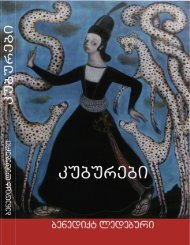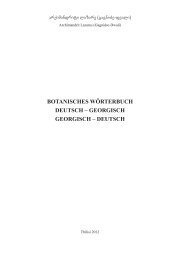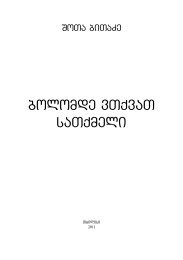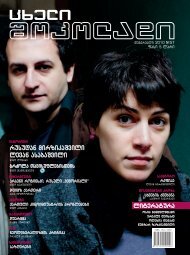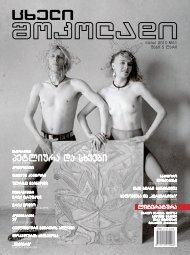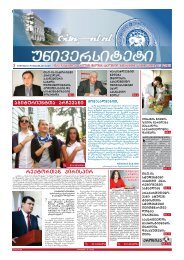Untitled - Iverieli
Untitled - Iverieli
Untitled - Iverieli
You also want an ePaper? Increase the reach of your titles
YUMPU automatically turns print PDFs into web optimized ePapers that Google loves.
Ramaz Khalvashi<br />
APOSTLE ST. ANDREW IN GEORGIA<br />
Summary<br />
The oldest sources on St Andrew’s missionary activities are preserved<br />
in apocryphal literature in which two different traditions have been formed<br />
on the above mentioned issue. One part of the texts connects the apostle’s<br />
preaching to the Black Sea countries whereas the other part – to Scythia.<br />
Georgia was included into both missionary routes. Therefore the Roman<br />
and Byzantine authors specify the Iberian-Caucasian section of St Andrew’s<br />
preaching route and together with ancient Greek settlements include into it<br />
the following strategic centers of the Roman world: Trapezus (city in<br />
Lazika), Phasis (river of Chorokhi), fort of Apsarus (Gonio), the second<br />
Ethiopia (Cholchis), Iberia, Susania, Phusta, Abazgia, Sebastopolis<br />
(Sokhumi) and Nikophsia.<br />
The earliest information about St Andrew’s preaching in Georgia is<br />
found in the Georgian translations that were included into the polycefhalon<br />
(5 th -6 th centuries). It is confirmed by the Klarjeti polycefhalon (10 th century)<br />
according to which St Andrew preached among the population of the city of<br />
Sebastopol, in the camp of Apsarus, in the river Phasis (Chorokhi) basin and<br />
Ethiopians (Cholchians). The same missionary route is given in the old<br />
Georgian translation of Pseudo-Basil’s work The Most Holy Virgin’s<br />
Assumption.<br />
The echo of the existing ancient tradition about the apostle’s preaching<br />
in Georgia among the original Georgian works is first met in St Abo’s<br />
Martyrdom.<br />
In 1011 Eptvime Atoneli (955-1028) translated Nikita-David of<br />
Paphlagon’s St Andrew the Apostle’s Journeys (9 th century). This canonical<br />
hagiographic text confirms that Christianity was preached in Georgia by<br />
three apostles: Andrew the First-Called, Simon Kananaios and Matthias. In<br />
fact, The Journeys answered all the questions connected with the<br />
autocephaly of the Georgian Church as well as the apostles’ preaching.<br />
Therefore, all the later Georgian authors who studied St Andrew’s<br />
preaching issues referred exactly to this text.<br />
St. Giorgi Atoneli (1009-1066) used the Greek original of St Andrew<br />
the Apostle’s Journeys during the dispute (1057) with Theodosius II,<br />
Patriarch of Antioch, in defense of the apostolic nature of the Georgian<br />
Church and its autocephaly.<br />
153<br />
In the second half of the 9 th century Leonti Mroveli included the<br />
information on the apostles’ preaching into the official history of Georgia –<br />
Kartlis Tskhovreba (Georgian Chronicles) and put more emphasis on the<br />
conversion of Western Georgia (Egrisi and Abkhazia) to Christianity. At the<br />
same time he confirmed that the expression «up to the river Chorokhi» in<br />
the Journeys means St Andrew’s preaching «on the way to Klarjeti».<br />
With the same logic, the monk Arsen named one more province – «the<br />
villages of Nigali» in the Apostle’s missionary route in the Chorokhi basin,<br />
thus defining the location of «Sosangeti village» in the text of the Journeys<br />
(metaphrastic edition of St Nino’s Life).<br />
Leonti Mroveli’s tradition was developed by Ioane Ancheli according<br />
to whose hagiographic canon Chants of Anchi Icon St Apostle Andrew<br />
introduced into Klarjeti the heir of Hierapolis Keramidion – the icon of<br />
Anchi. This original opinion of the Bishop of Anchi can find its premises in<br />
Correspondence between Abgar and the Christ and St Andrew the Apostle’s<br />
Journeys.<br />
Leonti Mroveli’s History of Georgian Kings, Eprem Mtsire’s Story of<br />
Georgia’s Conversion, The Code of Ruis-Urbnisi Church Council (1104)<br />
and Monk Arsen’s St Nino’s Life explain the necessity of St Nino’s<br />
preaching by the fact that after the apostles Georgia again turned to<br />
paganism.<br />
At the same time, The Code spreads and generalizes the fact of St<br />
Andrew’s preaching throughout all Georgia and states that the apostle<br />
preached the Gospel «all through the country of Georgia».<br />
A different tendency can be noticed in the first Georgian edition of the<br />
Journeys and Meskhian tradition.<br />
The Georgia edition of the Journeys was formed in the 13 th -15 th<br />
centuries. It is presented in the full form in A-161 manuscript. The author of<br />
this edition «reads» the historical document from his contemporary<br />
perspective considers literary tradition and includes into Eptvime’s<br />
translation historical-geographical glosses the majority of which aims at<br />
vast depiction of Meskheti in the missionary journeys of Apostle Andrew.<br />
Together with the Chorokhi basin (Tao-Klarjeti-Nigali), the lands of the<br />
Mtkvari basin – Artaani and Kola – also emerge in the glosses (as it is<br />
known only the river Chorokhi is mentioned in the text of the Journeys).<br />
The Meskhian tradition (1486-1516) formed with the dictation and<br />
direct participation of Kvarkvare and Mzechabuk Atabagi expands St<br />
Andrew’s missionary route in two directions: it adds Adjara into the<br />
154



